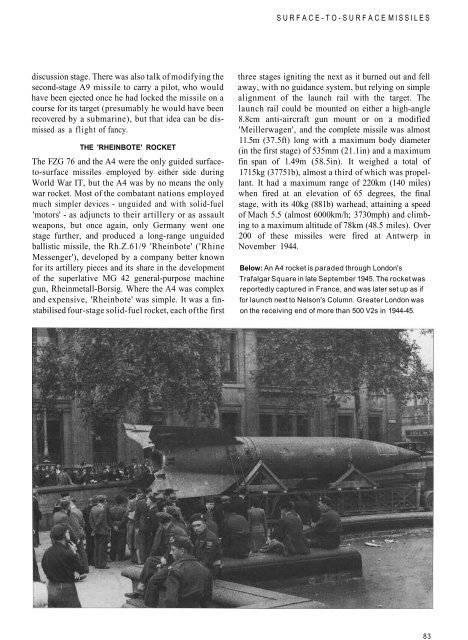Submarines and their Weapons - Aircraft of World War II
Submarines and their Weapons - Aircraft of World War II
Submarines and their Weapons - Aircraft of World War II
You also want an ePaper? Increase the reach of your titles
YUMPU automatically turns print PDFs into web optimized ePapers that Google loves.
discussion stage. There was also talk <strong>of</strong> modifying the<br />
second-stage A9 missile to carry a pilot, who would<br />
have been ejected once he had locked the missile on a<br />
course for its target (presumably he would have been<br />
recovered by a submarine), but that idea can be dismissed<br />
as a flight <strong>of</strong> fancy.<br />
THE 'RHEINBOTE' ROCKET<br />
The FZG 76 <strong>and</strong> the A4 were the only guided surfaceto-surface<br />
missiles employed by either side during<br />
<strong>World</strong> <strong>War</strong> IT, but the A4 was by no means the only<br />
war rocket. Most <strong>of</strong> the combatant nations employed<br />
much simpler devices - unguided <strong>and</strong> with solid-fuel<br />
'motors' - as adjuncts to <strong>their</strong> artillery or as assault<br />
weapons, but once again, only Germany went one<br />
stage further, <strong>and</strong> produced a long-range unguided<br />
ballistic missile, the Rh.Z.61/9 'Rheinbote' ('Rhine<br />
Messenger'), developed by a company better known<br />
for its artillery pieces <strong>and</strong> its share in the development<br />
<strong>of</strong> the superlative MG 42 general-purpose machine<br />
gun, Rheinmetall-Borsig. Where the A4 was complex<br />
<strong>and</strong> expensive, 'Rheinbote' was simple. It was a finstabilised<br />
four-stage solid-fuel rocket, each <strong>of</strong> the first<br />
SURFACE-TO-SURFACE MISSILES<br />
three stages igniting the next as it burned out <strong>and</strong> fell<br />
away, with no guidance system, but relying on simple<br />
alignment <strong>of</strong> the launch rail with the target. The<br />
launch rail could be mounted on either a high-angle<br />
8.8cm anti-aircraft gun mount or on a modified<br />
'Meillerwagen', <strong>and</strong> the complete missile was almost<br />
11.5m (37.5ft) long with a maximum body diameter<br />
(in the first stage) <strong>of</strong> 535mm (21.1in) <strong>and</strong> a maximum<br />
fin span <strong>of</strong> 1.49m (58.5in). It weighed a total <strong>of</strong><br />
1715kg (37751b), almost a third <strong>of</strong> which was propellant.<br />
It had a maximum range <strong>of</strong> 220km (140 miles)<br />
when fired at an elevation <strong>of</strong> 65 degrees, the final<br />
stage, with its 40kg (881b) warhead, attaining a speed<br />
<strong>of</strong> Mach 5.5 (almost 6000km/h; 3730mph) <strong>and</strong> climbing<br />
to a maximum altitude <strong>of</strong> 78km (48.5 miles). Over<br />
200 <strong>of</strong> these missiles were fired at Antwerp in<br />
November 1944.<br />
Below: An A4 rocket is paraded through London's<br />
Trafalgar Square in late September 1945. The rocket was<br />
reportedly captured in France, <strong>and</strong> was later set up as if<br />
for launch next to Nelson's Column. Greater London was<br />
on the receiving end <strong>of</strong> more than 500 V2s in 1944-45.<br />
83


